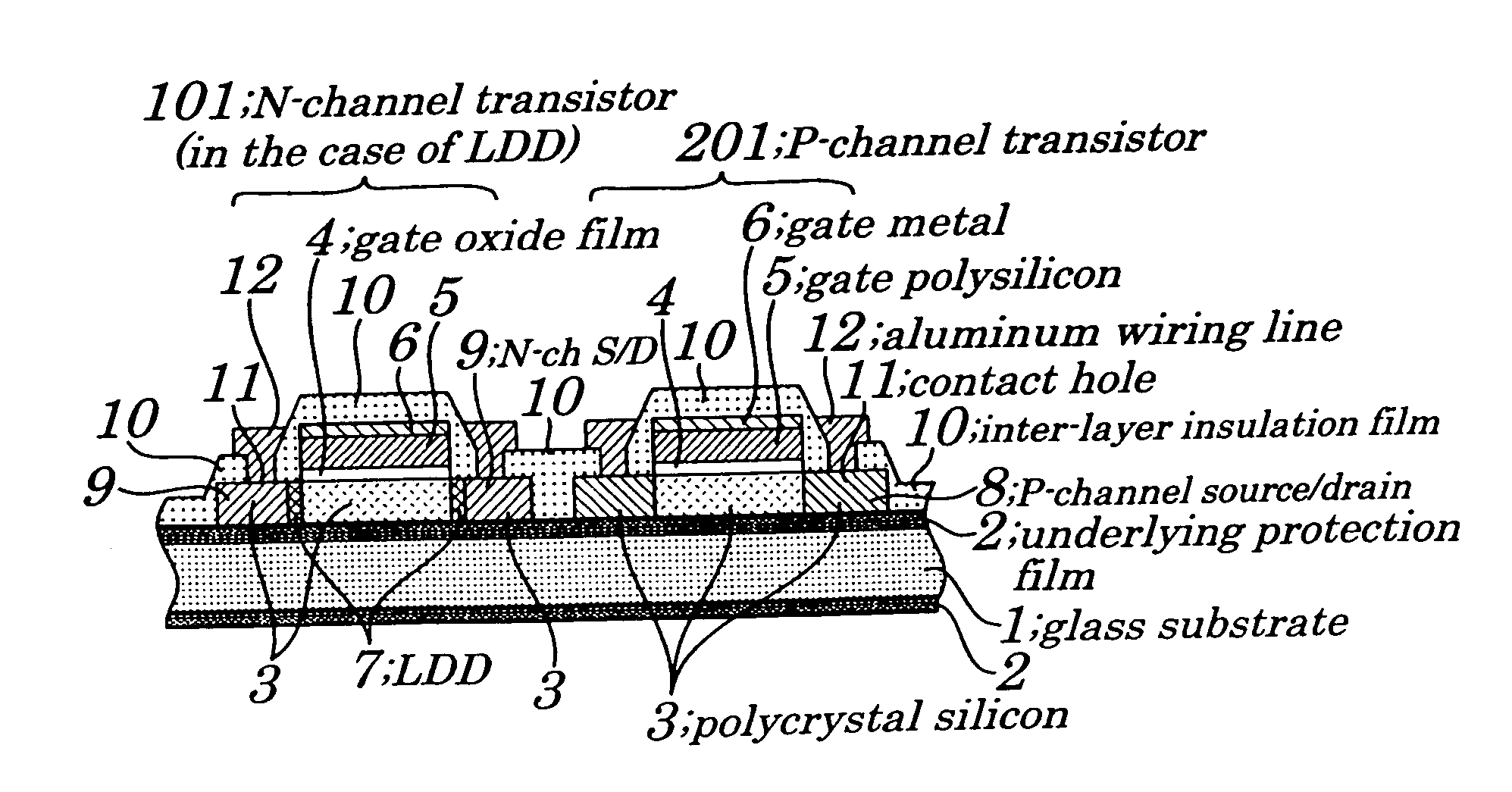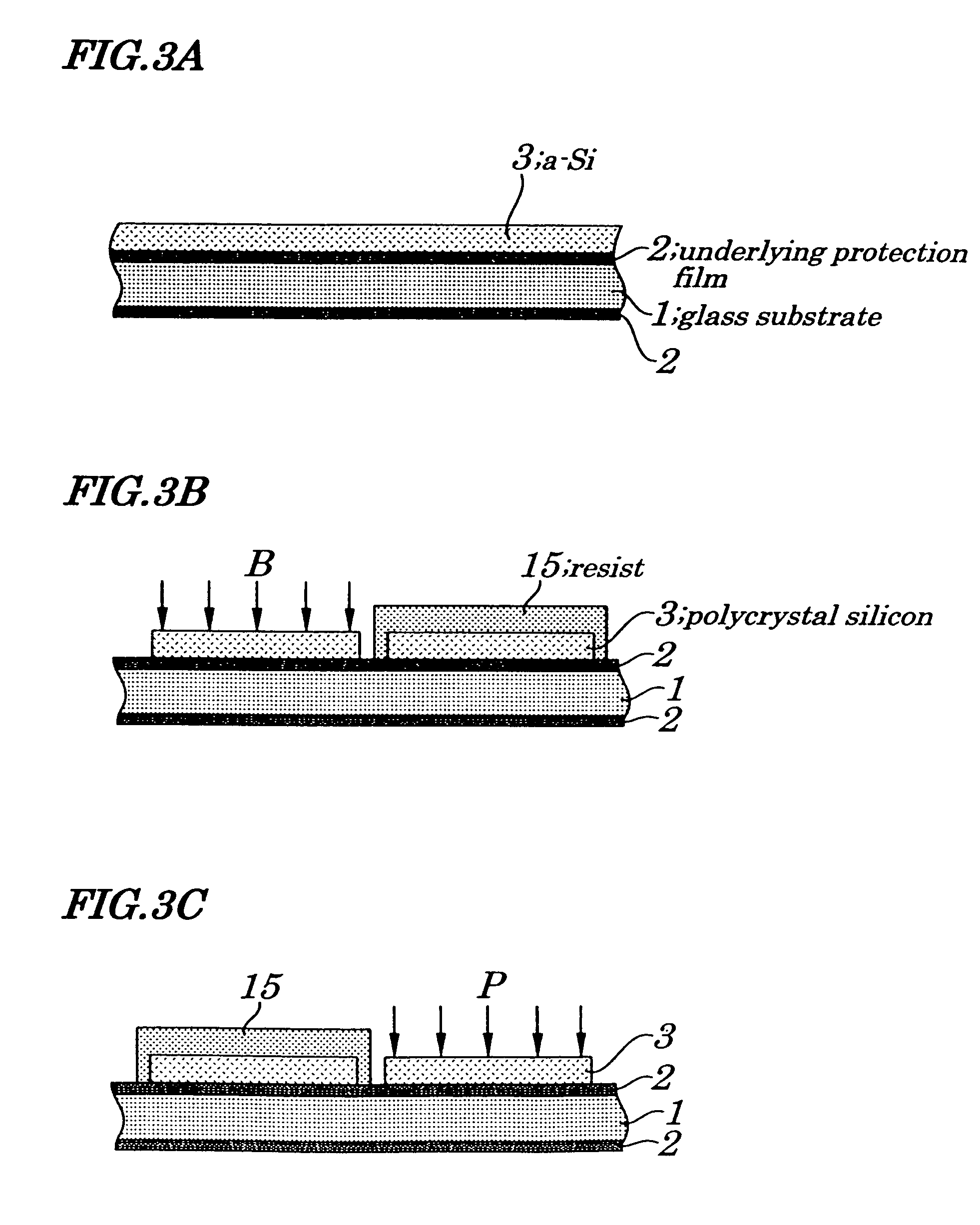Thin film semiconductor device and method for manufacturing same
a technology of thin film and semiconductors, applied in the direction of semiconductor devices, electrical devices, transistors, etc., to achieve the effect of reducing the fluctuation of the vth valu
- Summary
- Abstract
- Description
- Claims
- Application Information
AI Technical Summary
Benefits of technology
Problems solved by technology
Method used
Image
Examples
first embodiment
First, a thin film semiconductor device and method for manufacturing the same according to a first embodiment of the present invention is described with reference to FIGS. 1-2 and 3A-3H. Of these, FIGS. 3A-3H show one series of manufacturing steps and are actually divided for convenience of plotting.
The following will describe a thin film semiconductor device manufacturing method according to the first embodiment with reference to FIGS. 3A-3H. First, as shown in FIG. 3A, on a glass substrate 1 is formed an underlying protection film 2 made of SiO2 to a thickness of about 100 nm (1000 Å), on which is formed a-Si 3 by LP-CVD (Low Pressure Chemical Vapor Deposition) or PE-CVD (Plasma-Enhanced Chemical Vapor Deposition) to a thickness of about 60 nm. In the case where PE-CVD (Plasma-Enhanced Chemical Vapor Deposition) is employed in the formation, the a-Si 3 is dehydrogenated to 1% or less before the next step of crystallization by use of excimer laser or a like. Then, the substrate ...
second embodiment
The following will describe a thin film semiconductor device and method for manufacturing the same according to a second embodiment of the present invention, with reference to FIGS. 4A-4D. FIGS. 4A-4D are actually divided for convenience of plotting. In contrast to the above-mentioned first embodiment in which the present invention is applied to an LDD (Lightly Doped Drain) construction using a photo-resist process, the present embodiment applies the present invention to an LDD construction employing a self-alignment (SA) to hereby enable reducing the time required by the steps.
The method for manufacturing the thin film semiconductor device having this construction is shown in FIGS. 4A-4D. In these figures, the present embodiment uses the same steps as those of the first embodiment up to the growing of a gate oxide film 4. After that, as shown in FIG. 4A, gate polysilicon 5 is grown to a thickness of about 60 nm. Preferably the gate polysilicon 5 is formed roughly as thick as a t...
third embodiment
The following will describe a thin film semiconductor device and method for manufacturing the same according to a third embodiment of the present invention, with reference to FIGS. 5A-5C. In contrast to the above-mentioned second embodiment in which the present invention is applied to an LDD (Lightly Doped Drain) construction using SA (Self-Alignment), the present invention may be applied to an LDD construction using a side wall in the present embodiment.
The manufacturing method is described below with reference to FIGS. 5A-5C. In the figures, the present embodiment uses the same steps as those of the second embodiment up to the patterning of a gate polysilicon 5 making up a gate electrode through a gate dry etching process. After the gate electrode is patterned, a P-channel transistor's LDD is selectively formed (see FIG. 5A) by performing a lightly doped drain photo-resist process for Boron (B) doping and a subsequent boron (B) ion injection process (see FIG. 5A) and then an N-...
PUM
 Login to View More
Login to View More Abstract
Description
Claims
Application Information
 Login to View More
Login to View More - R&D
- Intellectual Property
- Life Sciences
- Materials
- Tech Scout
- Unparalleled Data Quality
- Higher Quality Content
- 60% Fewer Hallucinations
Browse by: Latest US Patents, China's latest patents, Technical Efficacy Thesaurus, Application Domain, Technology Topic, Popular Technical Reports.
© 2025 PatSnap. All rights reserved.Legal|Privacy policy|Modern Slavery Act Transparency Statement|Sitemap|About US| Contact US: help@patsnap.com



